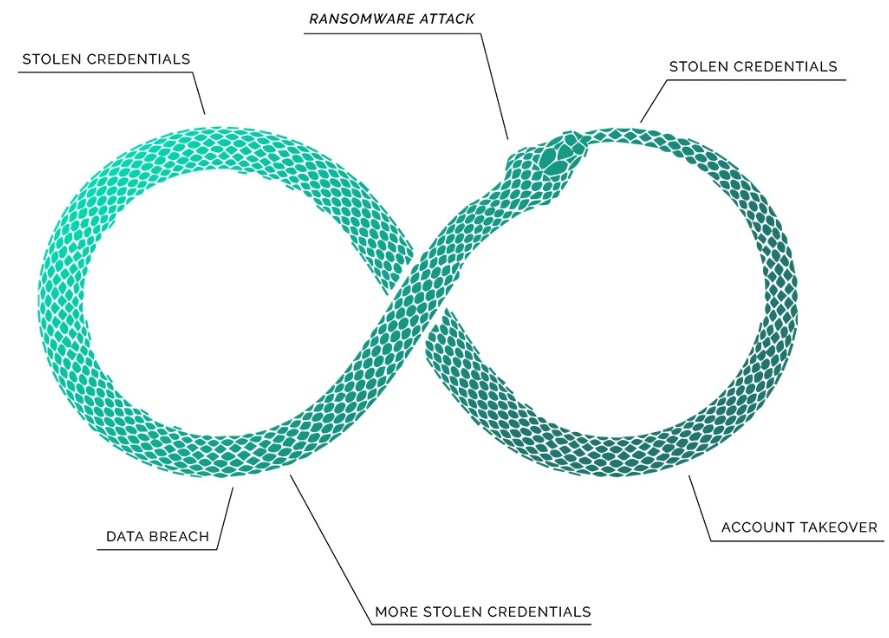The Verizon Data Breach Investigation Report (DBIR) is an invaluable resource that sheds light on the ever-evolving landscape of data breaches. The recently published 2023 report provides crucial insights into the latest trends and patterns observed in cyberattacks.
This article will explore seven key takeaways from the Verizon Data Breach Investigation Report 2023, highlighting the most significant findings and their implications.
- 7 Key Takeaways From Verizon’s Data Breach Investigation Report 2023
- 1. Stolen Credentials Are Still Cyber Criminal's Best Friend:
- 2. Ransomware Threat Continues To Haunt Businesses
- 3. Your Data Is No Longer Private
- 4. Sophisticated Web Provides New Opportunities To Threat Actors:
- 5. Human Error Is Still The Biggest Cause of Data Breaches:
- 6. Multi Factor Authentication Is Not Safe Anymore
- 7. Evolution of Tactics Forces Businesses To Redefine What a Credential Really Is
- Conclusion:
7 Key Takeaways From Verizon’s Data Breach Investigation Report 2023
Here are seven key takeaways from Verizon’s Data Breach Investigation Report 2023
1. Stolen Credentials Are Still Cyber Criminal’s Best Friend:
Unsurprisingly, the report reaffirms that stolen credentials remain the preferred weapon of choice for cybercriminals. Whether obtained through phishing, social engineering, or brute-force attacks, compromised credentials provide criminals with a direct pathway to exploit organizations’ systems and sensitive data. It underscores the urgent need for organizations to implement strong authentication mechanisms, multi-factor authentication (MFA), and robust password best practices.

2. Ransomware Threat Continues To Haunt Businesses
Ransomware attacks continue to surge and pose a significant threat to organizations across various industries. The report reveals that ransomware incidents have reached alarming levels, with attackers adopting increasingly sophisticated attack vectors and leveraging the anonymity of the dark web. It emphasizes the importance of proactive measures such as regular data backups, network segmentation, and comprehensive security awareness training to mitigate the impact and risk of ransomware attacks.

3. Your Data Is No Longer Private
The report highlights the growing concern of public exposure incidents, where organizations inadvertently expose sensitive data to the internet. Misconfigurations, poor database security, and cloud storage missteps have resulted in a substantial number of breaches. Organizations must prioritize robust security configurations, regular vulnerability assessments, and encryption best practices to prevent the accidental exposure of sensitive information.
4. Sophisticated Web Provides New Opportunities To Threat Actors:
As organizations increasingly rely on web applications, the report emphasizes the persistent threat posed by web application attacks. Vulnerabilities in web applications provide entry points for attackers to exploit and compromise systems. Regular security assessments, secure coding practices, and web application firewalls (WAFs) are essential to safeguard against web-based attacks.

5. Human Error Is Still The Biggest Cause of Data Breaches:
Human error continues to be a significant contributor to data breaches. In fact, 74% of data breaches contain a human element, whether it is in the form of human error, social engineering attack or misuse. The report reveals that insecure delivery of sensitive information and improper handling of data were among the top causes of breaches. Organizations should prioritize comprehensive security training programs to educate employees about data handling best practices, establish clear protocols for handling sensitive information, and implement robust data loss prevention (DLP) controls.

6. Multi Factor Authentication Is Not Safe Anymore
While multi-factor authentication (MFA) is a critical security measure, the report cautions against relying solely on MFA for protection. Attackers have developed techniques to bypass MFA, such as SIM swapping and phishing attacks targeting MFA codes. Organizations must adopt a defense-in-depth approach, combining MFA with other security measures like behavior analytics, user monitoring, and adaptive access controls.
7. Evolution of Tactics Forces Businesses To Redefine What a Credential Really Is
The report stresses the need for organizations to adapt and evolve their understanding of credentials. It highlights the importance of considering not only traditional credentials like usernames and passwords but also other forms of digital identity, such as API keys, cryptographic keys, and machine identities. Organizations should implement robust identity and access management (IAM) practices, regularly review privileged access, and establish stringent controls over all types of credentials.
Conclusion:
The Verizon Data Breach Investigation Report 2023 provides crucial insights into the evolving landscape of data breaches. Understanding the significance of stolen credentials, the persistence of ransomware attacks, the risks of public exposure incidents, the vulnerabilities in web applications, the impact of supply chain attacks, and the rise of nation-state threats is essential for organizations to enhance their cybersecurity measures. The report underscores the importance of proactive threat intelligence, robust authentication mechanisms, regular security audits, and employee awareness training to mitigate the growing threat of data breaches..
Furthermore, the report emphasizes the necessity of collaboration and information sharing among organizations, industry sectors, and even international entities to combat the increasingly sophisticated nature of cybersecurity threats. By pooling resources, sharing best practices, and collectively addressing vulnerabilities, stakeholders can collectively bolster their defenses and stay ahead of threat actors. In conclusion, the Verizon Data Breach Investigation Report 2023 serves as a wake-up call for organizations worldwide.
Which is the biggest takeaway from Verizon’s data breach investigation report 2023 in your opinion? Share your thoughts with us in the comments section below.





Add comment